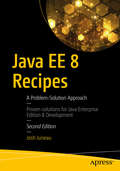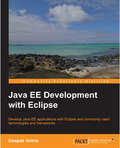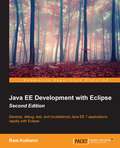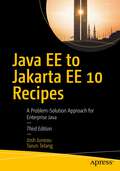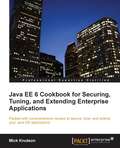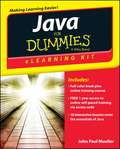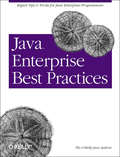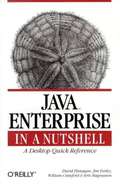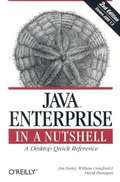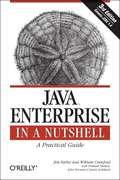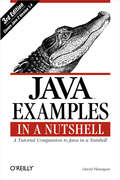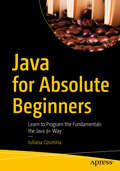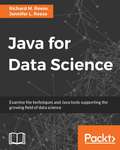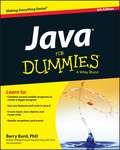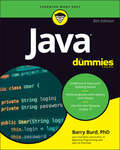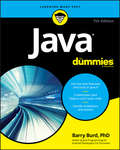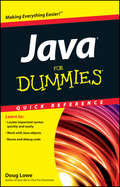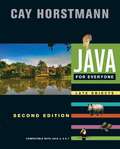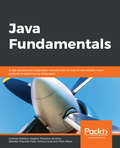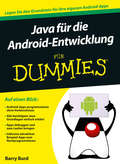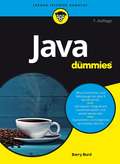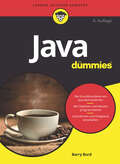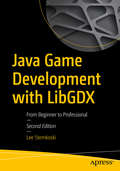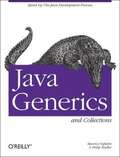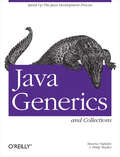- Table View
- List View
Java EE 8 Recipes: A Problem-Solution Approach
by Josh JuneauQuickly find solutions to dozens of common programming problems with the Java Enterprise Edition Platform for small business web applications, enterprise database applications, and microservices solutions. Content is presented in the popular problem-solution format. Look up the programming problem that you want to solve. Read the solution. Apply the solution directly in your own code. Problem solved!Java EE 8 Recipes provides you with effective and proven solutions that can be used to accomplish just about any task that you may encounter. You can feel confident using the reliable solutions that are demonstrated in this book in your personal or corporate environment.Java is a mature programming language that has been refined over the years into a productive and lucrative language for those with the skills to wield it. One result of this years-long refining process is that that the language carries forward many older feature sets that no longer represent the best way of getting work accomplished. You can rest assured that Java EE 8 Recipes provides solutions using the most current approaches implemented in the most current Java Enterprise technologies, including JSON-P 1.1, JSF 2.3, and JAX-RS 2.1. Build a streamlined and reliable application that uses the latest in Java technologies, and develop it much faster than you did with the older technologies. Rejuvenate your Java expertise to use the freshest capabilities, or perhaps learn Java Enterprise development for the first time and discover one of the most widely used and most powerful technologies available for application development today. Develop productively. Develop with proven technology. Develop with Java Enterprise Edition. The book: Teaches how to develop RESTful enterprise applications quickly using the most current Java EE technologiesExplores different solutions for developing sophisticated web user interfacesWalks you through a myriad of different concepts to apply while working with databases using Java technologiesWhat You'll LearnDevelop Java Enterprise applications using the latest in Java EE technologiesBuild great-looking user interfaces using Java Server FacesEmploy Java Servlet technology and standard frameworks in developing professional web applicationsCreate enterprise-level database applications using Enterprise Java Beans and JAX-RS RESTFul web servicesMake use of Arquillian to build a cohesive test suite for Java EE applicationsManage Java EE application security through Java EE's container feature setWho This Book Is ForJava developers who want to develop effective and proven solutions without reading a lengthy manual and scrubbing for techniques. A beginning Java programmer will find the book handy for learning a variety of different solutions for the platform, while advanced developers will enjoy the ease of the problem-solution approach to quickly broaden their knowledge of the platform’s latest technologies.
Java EE Development with Eclipse
by Deepak VohraThis book is step-by-step tutorial guide and a background reference for developing applications with Oracle WebLogic Server and Oracle database, the most used application server and database for enterprise applications. This book is for professional Java EE developers. The book is also suitable for an intermediate/advanced course in Java development with Eclipse IDE. Some knowledge of the Java EE technologies and frameworks EJB, JSF, JAXB, JAX-WS, JAX-RS, Ajax, and Spring is required.
Java EE Development with Eclipse - Second Edition
by Ram KulkarniDevelop, debug, test, and troubleshoot Java EE 7 applications rapidly with Eclipse About This Book * Go beyond simply learning Java EE APIs and explore the complete workflow of developing enterprise Java applications * Learn to use the features of Eclipse JEE to simplify Java EE application development * Develop and deploy complete applications with JEE Who This Book Is For If you are a Java developer who has little or no experience in JEE application development or you have experience in JEE technology but are looking for tips to simplify and accelerate your development process, then this book is for you. What You Will Learn * Set up Eclipse, Tomcat, and Glassfish server for JEE application development * Use JSP, Servlet, JSF, and EJBs to create a user interface and write business logic * Create JEE database applications using JDBC and JPA * Handle asynchronous messages using MDBs for better scalability * Deploy and debug JEE applications and create SOAP and REST web services * Write unit tests and calculate code coverage * Troubleshoot application performance and memory issues In Detail Java EE is a technology for developing enterprise class, scalable applications. With recent changes to Java EE specifications, JEE application development has become a lot simpler. However, recent changes have also added many new specifications, some of which compete with existing JEE specification. Along with JEE specifications and APIs, it is also very important to understand the entire application development process and tools that can help simplify and accelerate JEE application development. This guide provides a complete overview of developing JEE applications using Eclipse. The many features of the Eclipse IDE are explained. These enable the rapid development, debugging, testing, and deployment of JEE applications. You'll explore not just different JEE technologies and how to use them (JSP, JSF, JPA, JDBC, EJB, web services etc.), but also suitable technologies for different scenarios. The book starts with how to set up the development environment for JEE applications and then goes on to describe many JEE specifications in detail, with an emphasis on examples. You'll learn how to deploy an example application on Tomcat and Glassfish Application Server. You'll create a simple application that reads from a queue, processes the request, and publishes results to a topic and Eclipse MAT (Memory Analysis Tool) to debug memory issues. Style and approach This guide takes a step-by-step approach to developing, testing, debugging, and troubleshooting JEE applications, complete with examples and tips.
Java EE to Jakarta EE 10 Recipes: A Problem-Solution Approach for Enterprise Java
by Josh Juneau Tarun TelangTake a problem-solution approach for programming enterprise Java or Java EE applications and microservices for cloud-based solutions, enterprise database applications, and even small business web applications. Java EE to Jakarta EE 10 Recipes provides effective, practical, and proven code snippets that you can immediately use to accomplish just about any task that you may encounter. You can feel confident using the reliable solutions that are demonstrated in this book in your personal or corporate environment. Java EE was made open source under the Eclipse Foundation, and Jakarta EE is the new name for what used to be termed the Java Platform, Enterprise Edition. This book helps you rejuvenate your Java expertise and put the platform’s latest capabilities to use for quickly developing robust applications. If you are new to Jakarta EE, this book will help you learn the features of the platform and benefit from one of the most widely used and powerful technologies available for cloud-native enterprise application development today. Examples in this book highlight Jakarta EE’s capabilities, helping you to build streamlined and reliable applications using the latest in Java technologies. The book takes a problem-solution approach in which each section introduces a common programming problem, showing you how to solve that problem in the best possible way using the latest features in Jakarta EE. Solutions in the form of working code examples are presented that you can download and use immediately in your own projects. Clear descriptions are provided to help you understand and learn to build further on the solutions provided. This is the ideal book for the code-focused programmer interested in keeping up with the future of enterprise development on the Java Platform. What You Will Learn Develop enterprise java applications using the latest open-source Jakarta EE platformCreate great-looking user interfaces using Jakarta Servlets, Jakarta Server Pages, Jakarta Server Faces and the Eclipse Krazo framework (an implementation of Jakarta MVC)Build database applications using Jakarta NoSQL, Jakarta Persistence, and Jakarta Enterprise Beans.Develop enterprise grade applications using Context & Dependency Injection, and Jakarta RESTFul web servicesAutomate testing through cohesive test suites built on Arquillian for Jakarta EE applicationsBuild loosely coupled distributed applications using Jakarta MessagingDeploy microservices applications in cloud environments using DockerSecure applications utilizing the Jakarta EE Security API Who This Book Is For Java developers interested in quickly finding effective and proven solutions without reading through a lengthy manual and scrubbing for techniques.
Java EE6 Cookbook for securing, tuning, and extending enterprise applications
by Mick KnutsonThis book is part of Packt's Cookbook series. A Packt Cookbook contains step-by-step recipes for solutions to the most important problems you face when working with a topic. This book is aimed at Java developers and programmers who want to secure, tune and, extend their Java EE applications.
Java eLearning Kit For Dummies
by John Paul MuellerA complete book-and-online course package for learning Java!As a platform-independent, object-oriented programming language, Java helps developers write once and run anywhere. With this dynamic combination of a full-color printed book and a Dummies online interactive eLearning course, you'll find a wealth of information on the latest release of Java. Featuring both written and animated step-by-step how-tos, practice labs, helpful videos, numerous examples, and a host of Dummies hints and tips, this package makes your learning process easier.Follow the material sequentially or jump in and out as you wish--it's set up so you can learn at your own pace. Throughout, you will benefit from illustrations, animations, voiceover explanations, and the option of closed captioning if you find you learn better when you can read the instructions.Helps self-motivated learners master Java, the leading object-oriented programming languageIncludes an easy-to-follow, full-color book and an online interactive Dummies eLearning Course that corresponds with the book available via access codeAllows you to follow the material sequentially or choose separate sections at your own time and paceOffers chapter summaries, practice exercises, discussions of concepts and essential terms, and much moreJava eLearning Kit For Dummies helps you maximize the potential of this dynamic programming language so you can work more efficiently.
Java Enterprise Best Practices
by O'Reilly Java AuthorsJava developers typically go through four "stages" in mastering Java. In the first stage, they learn the language itself. In the second stage, they study the APIs. In the third stage, they become proficient in the environment. It is in the fourth stage --"the expert stage"-- where things really get interesting, and Java Enterprise Best Practices is the tangible compendium of experience that developers need to breeze through this fourth and final stage of Enterprise Java mastery. Crammed with tips and tricks, Java Enterprise Best Practices distills years of solid experience from eleven experts in the J2EE environment into a practical, to-the-point guide to J2EE. Java Enterprise Best Practices gives developers the unvarnished, expert-tested advice that the man pages don't provide--what areas of the APIs should be used frequently (and which are better avoided); elegant solutions to problems you face that other developers have already discovered; what things you should always do, what things you should consider doing, and what things you should never do--even if the documentation says it's ok. Until Java Enterprise Best Practices, Java developers in the fourth stage of mastery relied on the advice of a loose-knit community of fellow developers, time-consuming online searches for examples or suggestions for the immediate problem they faced, and tedious trial-and-error. But Java has grown to include a huge number of APIs, classes, and methods. Now it is simply too large for even the most intrepid developer to know it all. The need for a written compendium of J2EE Best Practices has never been greater. Java Enterprise Best Practices focuses on the Java 2 Enterprise Edition (J2EE) APIs. The J2EE APIs include such alphabet soup acronyms as EJB, JDBC, RMI, XML, and JMX.
Java Enterprise in a Nutshell
by David Flanagan William Crawford Jim Farley Kris MagnussonJava Enterprise in a Nutshell is an indispensable quick reference for Java programmers who are writing distributed enterprise applications. The book provides fast-paced tutorials on the following Java Enterprise APIs: JDBC, a vendor-independent API for accessing relational database systems RMI, a Java-only approach to distributed computing that relies on remote method invocation Java IDL, a CORBA-based, language-independent approach to distributed computing Java servlets, a mechanism for extending a web server that allows Java code to perform tasks traditionally handled by CGI scripts JNDI, a generic Java API for working with networked naming and directory services Enterprise JavaBeans, a component model that separates high-level business logic from low-level housekeeping chores like security and transaction management These APIs are the building blocks of the Java 2 Platform, Enterprise Edition (J2EE), Sun's recently announced new platform for enterprise computing. J2EE is the standard Java 2 platform with a number of extensions for enterprise development. Java Enterprise in a Nutshell also contains O'Reilly's classic-style, quick-reference material for all of the classes in the various packages that comprise the Enterprise APIs. This material includes the core Enterprise APIs that are part of Java 1.2, as well as numerous standard extensions. This book is a companion to both Java in a Nutshell, 3rd Edition, which covers the key non-graphical, non-enterprise APIs in Java 1.2, and Java Foundation Classes in a Nutshell, which describes the graphics- and GUI-related classes of Java 1.2.
Java Enterprise in a Nutshell, 2nd Edition
by William Crawford Jim Farley David FlanaganNothing is as constant as change, and this is as true in enterprise computing as anywhere else. Since Java Enterprise in a Nutshell was first published in September of 1999, a dozen or more new APIs have been added to the platform, reflecting the new and different ways developers implement their enterprise objectives. And now developers are being called on to add even greater, more complex levels of interconnectivity to their applications, as the concepts behind Web Services solidify and implementation decisions need coding. Java developers today need a clear understanding of the new APIs, tools, capabilities and pitfalls in J2EE 2.0 so they can plan a technology and implementation strategy for new enterprise projects. Fortunately, this is exactly what they get with the new Java Enterprise in a Nutshell, 2nd edition ! Completely revised and updated for the new 2.0 version of Sun Microsystems Java Enterprise Edition software, Java Enterprise in a Nutshell 2nd edition covers all of the J2EE APIs, including RMI, Java IDL, JDBC, JNDI, Java Servlet, and Enterprise JavaBeans, with a fast-paced tutorial and compact reference on each technology. Then Java Enterprise in a Nutshell goes even further, providing a classic O'Reilly-style quick reference for all of the classes in the various packages that comprise the Enterprise APIs - covering the core enterprise APIs as well as numerous standard extensions.
Java Enterprise in a Nutshell, 3rd Edition
by William Crawford Jim FarleyNothing is as constant as change, and this is as true in enterprise computing as anywhere else. With the recent release of Java 2 Enterprise Edition 1.4, developers are being called on to add even greater, more complex levels of interconnectivity to their applications. To do this, Java developers today need a clear understanding of how to apply the new APIs, use the latest open source Java tools, and learn the capabilities and pitfalls in Java 2 Enterprise Edition 1.4 -- so they can plan a technology and implementation strategy for new enterprise projects. Fortunately, this is exactly what they get with the new Java Enterprise in a Nutshell , 3rd Edition. Because most integrated development environments (IDE) today include API lookup, we took out the main API sections from our previous edition to make room for new chapters, among others, on Ant, Cactus, Hibernate, Jakarta Struts, JUnit, security, XDoclet, and XML/JAXP. Revised and updated for the new 1.4 version of Sun Microsystems Java Enterprise Edition software, Java Enterprise in a Nutshell , 3rd Edition is a practical guide for enterprise Java developers.
Java Examples in a Nutshell
by David FlanaganThe author of the best-selling Java in a Nutshell has created an entire book of real-world Java programming examples that you can learn from. If you learn best "by example," this is the book for you. This third edition covers Java 1.4 and contains 193 complete, practical examples: over 21,900 lines of densely commented, professionally written Java code, covering 20 distinct client-side and server-side APIs. It includes new chapters on the Java Sound API and the New I/O API. The chapters on XML and servlets have been rewritten to cover the latest versions of the specifications and to demonstrate best practices for Java 1.4. New and updated examples throughout the book demonstrate many other new Java features and APIs. Java Examples in a Nutshell is a companion volume to Java in a Nutshell, Java Foundation Classes in a Nutshell, and Java Enterprise in a Nutshell. It picks up where those quick references leave off, providing a wealth of examples for both novices and experts. This book doesn't hold your hand; it simply delivers well-commented working examples with succinct explanations to help you learn and explore Java and its APIs. Java Examples in a Nutshell contains examples that demonstrate: Core APIs, including I/O, New I/O, threads, networking, security, serialization, and reflection Desktop APIs, highlighting Swing GUIs, Java 2D graphics, preferences, printing, drag-and-drop, JavaBeans, applets, and sound Enterprise APIs, including JDBC (database access), JAXP (XML parsing and transformation), Servlets 2.4, JSP 2.0 (JavaServer Pages), and RMI The book begins with introductory examples demonstrating structured and object-oriented programming techniques for new Java programmers. A special index at the end of the book makes it easy to look up examples that use a particular Java class or accomplish a desired task. In between, each chapter includes exercises that challenge readers and suggest further avenues for exploration.
Java for Absolute Beginners: Learn to Program the Fundamentals the Java 9+ Way
by Iuliana CosminaWrite your first code in Java using simple, step-by-step examples that model real-word objects and events, making learning easy. With this book you’ll be able to pick up the concepts without fuss. Java for Absolute Beginners teaches Java development in language anyone can understand, giving you the best possible start. You’ll see clear code descriptions and layout so that you can get your code running as soon as possible. After reading this book, you'll come away with the basics to get started writing programs in Java.Author Iuliana Cosmina focuses on practical knowledge and getting up to speed quickly—all the bits and pieces a novice needs to get started programming in Java. First, you’ll discover how Java is executed, what type of language it is, and what it is good for. With the theory out of the way, you’ll install Java, choose an editor such as IntelliJ IDEA, and write your first simple Java program. Along the way you’ll compile and execute this program so it can run on any platform that supports Java. As part of this tutorial you’ll see how to write high-quality code by following conventions and respecting well-known programming principles, making your projects more professional and efficient.Finally, alongside the core features of Java, you’ll learn skills in some of the newest and most exciting features of the language: Generics, Lambda expressions, modular organization, local-variable type inference, and local variable syntax for Lambda expressions.Java for Absolute Beginners gives you all you need to start your Java 9+ programming journey. No experience necessary. What You'll LearnUse data types, operators, and the new stream APIInstall and use a build tool such as GradleBuild interactive Java applications with JavaFX Exchange data using the new JSON APIs Play with images using multi-resolution APIsUse the publish-subscribe frameworkWho This Book Is ForThose who are new to programming and who want to start with Java.
Java for Data Science
by Richard M. Reese Jennifer L. ReeseExamine the techniques and Java tools supporting the growing field of data science About This Book • Your entry ticket to the world of data science with the stability and power of Java • Explore, analyse, and visualize your data effectively using easy-to-follow examples • Make your Java applications more capable using machine learning Who This Book Is For This book is for Java developers who are comfortable developing applications in Java. Those who now want to enter the world of data science or wish to build intelligent applications will find this book ideal. Aspiring data scientists will also find this book very helpful. What You Will Learn • Understand the nature and key concepts used in the field of data science • Grasp how data is collected, cleaned, and processed • Become comfortable with key data analysis techniques • See specialized analysis techniques centered on machine learning • Master the effective visualization of your data • Work with the Java APIs and techniques used to perform data analysis In Detail Data science is concerned with extracting knowledge and insights from a wide variety of data sources to analyse patterns or predict future behaviour. It draws from a wide array of disciplines including statistics, computer science, mathematics, machine learning, and data mining. In this book, we cover the important data science concepts and how they are supported by Java, as well as the often statistically challenging techniques, to provide you with an understanding of their purpose and application. The book starts with an introduction of data science, followed by the basic data science tasks of data collection, data cleaning, data analysis, and data visualization. This is followed by a discussion of statistical techniques and more advanced topics including machine learning, neural networks, and deep learning. The next section examines the major categories of data analysis including text, visual, and audio data, followed by a discussion of resources that support parallel implementation. The final chapter illustrates an in-depth data science problem and provides a comprehensive, Java-based solution. Due to the nature of the topic, simple examples of techniques are presented early followed by a more detailed treatment later in the book. This permits a more natural introduction to the techniques and concepts presented in the book. Style and approach This book follows a tutorial approach, providing examples of each of the major concepts covered. With a step-by-step instructional style, this book covers various facets of data science and will get you up and running quickly.
Java For Dummies
by BurdThe top-selling beginning Java book is now fullyupdated!As an unstoppably platform-independent, object-orientedprogramming language, Java is used for developing web and mobileapplications. In this up-to-date bestselling book, veteran authorBarry Burd shows you how to create basic Java objects and clearlyexplains when you should simply reuse existing code.Explores how the new version of Java offers more robustfunctionality and new features such as closures to keep Javacompetitive with more syntax-friendly languages like Python andRubyCovers object-oriented programming basics with Java, codereuse, the essentials of creating a Java program using the new JDK7, creating basic Java objects, and new Eclipse featuresFeatures a companion website that offers all code from the bookand bonus chaptersJava For Dummies, 6th Edition gets you started withcreating Java applications quickly and easily.
Java For Dummies
by Barry BurdLearn to write practical, reusable code with the straightforward tutorials and tips in the newest edition of this For Dummies bestseller Do you speak Java? No, we’re not talking about your morning cup ‘o joe. We mean the world’s most popular programming language that runs on almost any computer! If you’re looking to get started—or up your game—with Java, then Java For Dummies is the guide you need. In this book, you’ll: Take control of your program flow Program with classes, objects, and methods Use Java's functional programming features Explore Java 17, the latest long-term support release This up-to-date handbook covers the latest developments in Java, including the new ‘switch’ statement syntax. So, if you’re ready to dive into one of the most practical (and coolest!) programming languages around, it’s time you picked up Java For Dummies.
Java For Dummies
by Barry A. BurdA new edition of the bestselling guide to Java If you want to learn to speak the world’s most popular programming language like a native, Java For Dummies is your ideal companion. With a focus on reusing existing code, it quickly and easily shows you how to create basic Java objects, work with Java classes and methods, understand the value of variables, learn to control program flow with loops or decision-making statements, and so much more! Java is everywhere, runs on almost any computer, and is the engine that drives the coolest applications. Written for anyone who’s ever wanted to tackle programming with Java but never knew quite where to begin, this bestselling guide is your ticket to success! Featuring updates on everything you’ll encounter in Java 9—and brimming with tons of step-by-step instruction—it’s the perfect resource to get you up and running with Java in a jiffy! Discover the latest features and tools in Java 9 Learn to combine several smaller programs to create a bigger program Create basic Java objects and reuse code Confidently handle exceptions and events If you’re ready to jump into Java, this bestselling guide will help keep your head above water!
Java For Dummies Quick Reference
by LoweA reference that answers your questions as you move through your codingThe demand for Android programming and web apps continues to grow at an unprecedented pace and Java is the preferred language for both. Java For Dummies Quick Reference keeps you moving through your coding while you solve a problem, look up a command or syntax, or search for a programming tip. Whether you're a Java newbie or a seasoned user, this fast reference offers you quick access to solutions without requiring that you wade through pages of tutorial material. Leverages the true reference format that is organized with quick answers and solutions so you can read less and do more Offers new elements such as a syntax guide, command guide, special generics and annotation section, and programming tips Boasts a new, compact trim size that easily goes where you go for convenient referencing Java For Dummies Quick Reference helps you move quickly and efficiently through Java without missing a beat!
Java For Everyone: Late Objects
by Cay HorstmannThis book is an introduction to Java and computer programming that focuses on the essentials--and on effective learning. The book is designed to serve a wide range of student interests and abilities and is suitable for a first course in programming for computer scientists, engineers, and students in other disciplines.
Java Fundamentals: A fast-paced and pragmatic introduction to one of the world's most popular programming languages
by Arnav GuptaJava Fundamentals is designed for tech-enthusiasts, who are familiar with some programming language, and now want a quick introduction to the most important principles of Java.
Java für die Android-Entwicklung für Dummies (Für Dummies)
by Barry BurdAlle Java-Grundlagen für die App-Entwicklung Sie möchten eigene Android-Apps entwickeln, können aber noch nicht programmieren oder zumindest noch kein Java? Dann ist dieses Buch wie für Sie gemacht. Nach der Installation der kostenlosen Entwicklungswerkzeuge lernen Sie Schritt für Schritt alle wichtigen Code-Elemente wie Variablen, Methoden und Schleifen sowie die objektorientierte Programmierung kennen. Außerdem erfahren Sie, wie Android-Apps aufgebaut sind, wie Sie sie mit Buttons, Auswahllisten und Layouts ausstatten und die Programmlogik mit Java erstellen. Anhand eines Spiels und einer Twitter-App sehen Sie, wie alles zusammenhängt. So steht Ihren eigenen Apps nichts mehr im Weg!
Java für Dummies (FÜr Dummies)
by Barry BurdJava für Dummies ist gleichzeitig ein Lehrbuch und ein unverzichtbares Nachschlagewerk für alle Java-Programmierer. Basiswissen zur objektorientierten Programmierung wird genauso vermittelt wie das Prinzip der Wiederverwendbarkeit von Programmbausteinen und allgemeine Grundlagen der Java-Programmierung.
Java für Dummies (Für Dummies)
by Barry BurdSie wollen in Java einsteigen oder Ihre Kenntnisse erweitern? »Java für Dummies« ist gleichzeitig Lehrbuch und unverzichtbares Nachschlagewerk für alle Java-Programmierer. Basiswissen zur objektorientierten Programmierung wird genauso vermittelt wie das Prinzip der Wiederverwendbarkeit von Programmbausteinen. Außerdem lernen Sie, wann Variablen innerhalb oder außerhalb von Methoden deklariert werden sollten, wo die Grenzen von Arrays liegen und wie Code mit Exceptions absturzsicher gemacht wird. Diese Auflage von »Java für Dummies« berücksichtigt die Neuerungen der Version Java 17.
Java Game Development with LibGDX
by Lee StemkoskiDesign and create video games using Java, with the LibGDX software library. By reading Beginning Java Game Development with LibGDX, you will learn how to design video game programs and how to build them in Java. You will be able to create your own 2D games, using various hardware for input (keyboard/mouse, gamepad controllers, or touchscreen), and create executable versions of your games. The LibGDX library facilitates the game development process by providing pre-built functionality for common tasks. It is a free, open source library that includes full cross-platform compatibility, so programs written using this library can be compiled to run on desktop computers (Windows/MacOS), web browsers, and smartphones/tablets (both Android and iOS). Beginning Java Game Development with LibGDX teaches by example with many game case study projects that you will build throughout the book. This ensures that you will see all of the APIs that are encountered in the book in action and learn to incorporate them into your own projects. The book also focuses on teaching core Java programming concepts and applying them to game development. What You Will Learn How to use the LibGDX framework to create a host of 2D arcade game case studies How to compile your game to run on multiple platforms, such as iOS, Android, Windows, and MacOS How to incorporate different control schemes, such as touchscreen, gamepad, and keyboard Who This Book Is For Readers should have an introductory level knowledge of basic Java programming. In particular, you should be familiar with: variables, conditional statements, loops, and be able to write methods and classes to accomplish simple tasks. This background is equivalent to having taken a first-semester college course in Java programming.
Java Generics and Collections
by Maurice Naftalin Philip WadlerThis comprehensive guide shows you how to master the most important changes to Java since it was first released. Generics and the greatly expanded collection libraries have tremendously increased the power of Java 5 and Java 6. But they have also confused many developers who haven't known how to take advantage of these new features. Java Generics and Collections covers everything from the most basic uses of generics to the strangest corner cases. It teaches you everything you need to know about the collections libraries, so you'll always know which collection is appropriate for any given task, and how to use it. Topics covered include: Fundamentals of generics: type parameters and generic methods Other new features: boxing and unboxing, foreach loops, varargs Subtyping and wildcards Evolution not revolution: generic libraries with legacy clients and generic clients with legacy libraries Generics and reflection Design patterns for generics Sets, Queues, Lists, Maps, and their implementations Concurrent programming and thread safety with collections Performance implications of different collections Generics and the new collection libraries they inspired take Java to a new level. If you want to take your software development practice to a new level, this book is essential reading. Philip Wadler is Professor of Theoretical Computer Science at the University of Edinburgh, where his research focuses on the design of programming languages. He is a co-designer of GJ, work that became the basis for generics in Sun's Java 5.0. Maurice Naftalin is Technical Director at Morningside Light Ltd., a software consultancy in the United Kingdom. He has most recently served as an architect and mentor at NSB Retail Systems plc, and as the leader of the client development team of a major UK government social service system. "A brilliant exposition of generics. By far the best book on the topic, it provides a crystal clear tutorial that starts with the basics and ends leaving the reader with a deep understanding of both the use and design of generics." Gilad Bracha, Java Generics Lead, Sun Microsystems
Java Generics and Collections
by Philip Wadler Maurice NaftalinThis comprehensive guide shows you how to master the most important changes to Java since it was first released. Generics and the greatly expanded collection libraries have tremendously increased the power of Java 5 and Java 6. But they have also confused many developers who haven't known how to take advantage of these new features. Java Generics and Collections covers everything from the most basic uses of generics to the strangest corner cases. It teaches you everything you need to know about the collections libraries, so you'll always know which collection is appropriate for any given task, and how to use it. Topics covered include:Fundamentals of generics: type parameters and generic methods Other new features: boxing and unboxing, foreach loops, varargs Subtyping and wildcards Evolution not revolution: generic libraries with legacy clients and generic clients with legacy libraries Generics and reflection Design patterns for generics Sets, Queues, Lists, Maps, and their implementations Concurrent programming and thread safety with collections Performance implications of different collections Generics and the new collection libraries they inspired take Java to a new level. If you want to take your software development practice to a new level, this book is essential reading. Philip Wadler is Professor of Theoretical Computer Science at the University of Edinburgh, where his research focuses on the design of programming languages. He is a co-designer of GJ, work that became the basis for generics in Sun's Java 5.0. Maurice Naftalin is Technical Director at Morningside Light Ltd., a software consultancy in the United Kingdom. He has most recently served as an architect and mentor at NSB Retail Systems plc, and as the leader of the client development team of a major UK government social service system. "A brilliant exposition of generics. By far the best book on the topic, it provides a crystal clear tutorial that starts with the basics and ends leaving the reader with a deep understanding of both the use and design of generics." Gilad Bracha, Java Generics Lead, Sun Microsystems
